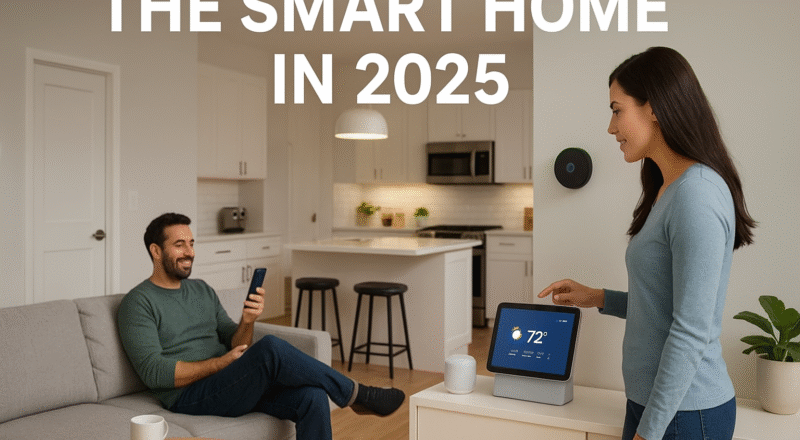Introduction: From Sci-Fi to Reality
For decades, the idea of a “smart home” was confined to science fiction. Hollywood painted pictures of houses that talked back, fridges that refilled themselves, and rooms that responded to a person’s mood. Fast forward to 2025, and much of that vision has become reality for millions of Americans.
Voice assistants no longer just play music or answer weather questions—they now anticipate needs, adjust energy usage in real-time, and even recommend healthier food choices. Refrigerators scan expiration dates, thermostats predict your ideal temperature, and smart locks recognize family members without a key.
But the question remains: Are we finally living in the future—or just in a more complicated, hyper-connected version of the present?
AI-Powered Assistants: The Brain of the Modern Home
At the heart of every smart home in 2025 is artificial intelligence.
-
Alexa 3.0, Google Home Max, and Siri AI+ have moved beyond simple commands. They now use predictive AI models that learn a user’s habits, preferences, and schedules.
-
Instead of asking Alexa to turn off the lights, the assistant already knows when you’re about to head to bed based on biometric cues from your smartwatch.
-
Siri AI+ integrates with Apple Vision Pro to create augmented-reality dashboards of your home, allowing you to check your thermostat, garage door, and kitchen appliances with a simple glance.
This marks a shift from reactive technology to proactive living assistance.
Smart Appliances: Everyday Life Gets an Upgrade
The biggest leap forward in 2025 has been the rise of AI-driven appliances.
-
Smart refrigerators now come with cameras, barcode scanners, and AI-powered nutrition advisors. They automatically generate shopping lists, suggest recipes, and even place online grocery orders.
-
Ovens and stoves monitor food while cooking, adjusting temperature and timing to avoid burning—ideal for busy families.
-
Laundry machines detect fabric types and detergent needs, ensuring better energy efficiency and water conservation.
American companies like Whirlpool, GE, and Samsung USA are leading the charge, while startups are pushing innovations in voice-controlled kitchens and self-cleaning bathrooms.
Privacy & Security: A Double-Edged Sword
As homes become “smarter,” the security conversation has never been louder.
-
Smart locks now rely on facial recognition and biometrics. But hackers have also become more sophisticated, targeting vulnerabilities in cloud-connected devices.
-
Consumer advocacy groups in the U.S. warn of “data-hungry homes” that constantly collect sensitive information, from voice recordings to eating habits.
-
In response, lawmakers are considering stricter federal regulations on IoT devices, requiring transparency in how companies use customer data.
Americans are left with a paradox: smarter homes promise comfort and efficiency, but they also create new privacy headaches.
Energy Efficiency & Sustainability: Smarter, Greener Living
One of the most celebrated aspects of the smart home revolution is its impact on energy conservation.
-
Smart thermostats like Nest Ultra and Ecobee+ now adjust settings not just by room occupancy, but also by analyzing energy grid demand.
-
Smart plugs automatically cut phantom energy consumption from idle electronics.
-
Solar-panel integration has become mainstream, allowing homes to switch between renewable and traditional power sources based on cost and availability.
Studies show that smart homes in the U.S. can save households up to 30% annually on energy bills, making them not just futuristic, but financially practical.
U.S. Adoption Trends: Who’s Embracing the Future?
The adoption of smart home technology in America has skyrocketed in the past five years.
-
According to a 2025 report by Statista, over 70% of U.S. households now use at least one smart device, up from 40% in 2020.
-
Adoption is highest among Millennials and Gen Z homeowners, who grew up surrounded by tech.
-
Interestingly, older Americans are also catching up, with many retirees turning to smart health-monitoring devices integrated into home systems.
-
Urban areas see the fastest growth, but suburban smart homes are on the rise thanks to affordable bundles from providers like Amazon, Google, and Comcast.
Challenges: Are Smart Homes Too Smart?
While the vision of a futuristic home is attractive, it’s not without hurdles:
-
Cost: Fully upgrading a home can run from $10,000 to $50,000, limiting accessibility.
-
Compatibility Issues: Devices from different brands often don’t work seamlessly together. Despite the Matter Protocol’s launch in 2024, full interoperability remains elusive.
-
Learning Curve: Not all Americans are comfortable with constant voice commands and digital dashboards.
These challenges show that while the technology is here, adoption is still uneven across the U.S.
The Future: Toward Autonomous Homes
Looking ahead, the smart home may evolve into the autonomous home.
-
AI-driven systems could predict maintenance needs (like a leaky pipe) before they become problems.
-
Homes may soon self-manage grocery restocking, energy optimization, and security without any human input.
-
Integration with AI-powered wearables could create a truly personalized living space that adapts not just to your habits, but also to your health and emotions.
By 2030, experts believe that homes will shift from being tools we control to partners in daily living.
Conclusion: Are We Finally Living in the Future?
The answer is: yes and no.
In 2025, many Americans do live in homes that would have seemed impossible just a decade ago. Yet, challenges around privacy, affordability, and integration still prevent the “perfect smart home” from being universal.
What’s certain is that the future is no longer a concept—it’s happening inside American homes today.
